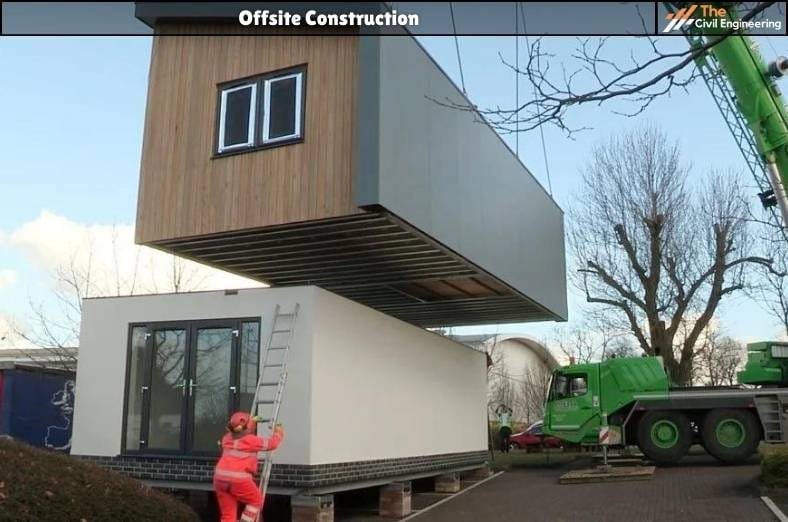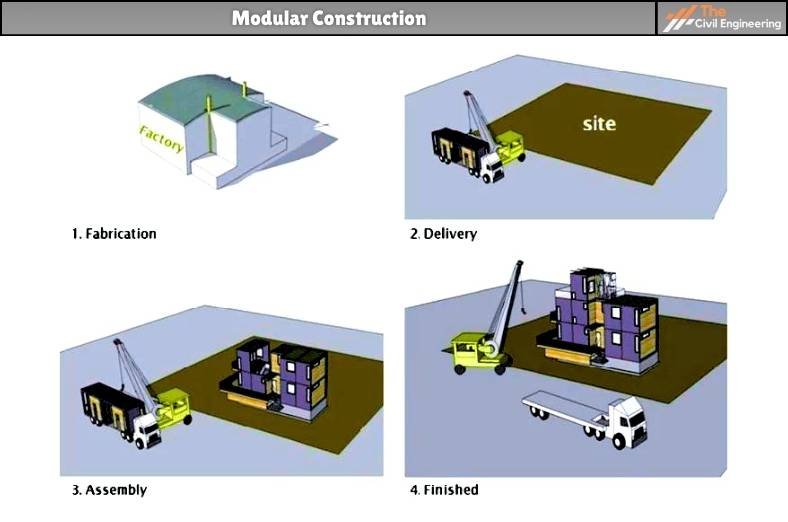1. Introduction
Offsite construction can be defined as the planning, designing, manufacturing, fabricating, and assembling of the elements of a building structure at a location other than the final site location.
Such elements of the building are mostly prefabricated and manufactured in a different location and duly transported to the final site location.
The primary objective of this construction is to ensure faster speed of construction and systematic completion of the construction.
It provides a higher degree of precision than traditional on-site construction.
Offsite construction is also commonly referred to as the Modern Method of construction, Modular Construction, or Prefabricated Construction.
One of the chief characteristics of offsite construction is integrated planning policies and supply chain optimization strategy.
It mainly includes offsite manufacturing (OSM), offsite production (OSP), and offsite fabrication (OSF).
The output structure of the offsite construction consists of elements that are componentized, panelized and modularized.
2. Suitability of Offsite Construction
a. When the project has to be completed within a very short period or has to achieve a tight deadline.
b. When the weather conditions at the site are extreme and pose a significant obstruction to the completion of the project.
c. When the construction of interior structures has to be carried out repeatedly.
d. When there is a limitation of space at the site.
e. When there exists a high risk of elements of vandalism and theft.
f. When the site is subjected to extreme conditions such as cold, hot, or great heights.
3. Types of Offsite Construction
a. Volumetric Offsite Construction
It includes the production of three-dimensional units, transportation of the units to the site, and the assembling of the units.
Mostly, the units are arranged and bolted together at the site.
The frame of the structure manufactured can be made up of steel, timber, or even concrete.
The volumetric offsite construction is also commonly referred to as modular construction.
It is further divided into the following two types:

Figure 2: Offsite Construction
a. Modular Construction
Modular construction is the type of volumetric construction in which the prefabricated and pre-engineered building components are produced in the factory and are delivered to the construction site.
These components are then duly assembled as large volumetric components or as substantial elements.

Figure 3: Modular Construction
b. Pod Construction
Pod construction is the type of volumetric offsite construction in which the three-dimensional elements are employed in the superstructure of the building.
Pods are the non-structural elements that are used in a load-bearing structure.
Such type of construction is most desirable for the construction of hotels and the accommodation spaces as this method facilitates the construction of ready-made rooms that can be duly combined to obtain a complete premise.
b. Hybrid Offsite Construction
Hybrid construction combines both volumetric and panelized approaches to develop a single building. Hence this construction is also called semi-volumetric.
Mostly, parts like the kitchen, bathroom, and bedroom are constructed as volumetric construction and the remaining part of the dwelling is constructed using the panels.
c. Panelized Offsite Construction
Panelized offsite construction includes the manufacturing of flat panel units in the form of walls, floors and roof tiles that can be used to form a complete shell of the structure.
These structural flooring and roofing units are also commonly referred to as cassettes.
Once the units are manufactured, they are transported to the site for assembling as a three-dimensional structure.
These panel units are built in the factory and transported to the site for assembling as a three-dimensional structure to fit into an already on-site constructed structure.
The manufactured structural units may be made up of insulated panels, light gauge steel, infill walls, or light gauge steel.

Figure 4: Panelized Construction
d. Sub-Assemblies and Accessories System
It includes the construction of the elements of the building at the offsite location and permanent arrangement at the site.
These elements mostly include the building components, materials, equipment, and prefabricated parts.
This construction is mostly employed for small building components like roof trusses, floors piping, staircases, roof trusses, etc.
| Read here: Road Maintenance |
4. Advantages of Offsite Construction
a. The weather condition does not affect the progress of construction.
b. Offsite constructions can be completed within a very short period.
c. It poses lesser safety risks than the traditional methods of construction.
d. The construction wastes produced are comparatively lesser.
e. It enables the construction of airtight buildings and other commercial structures.
f. The higher degree of precision and efficiency can be achieved with offsite construction.
g. It is more energy-efficient compared to the traditional method of construction.
h. Fewer disturbances are caused by the neighborhood and communities.
5. Disadvantages of Offsite Construction
a. Every location is not suitable.
b. It requires highly efficient planning and design phases to obtain the quality result.
c. It consists of restricted or limited customization.
d. It requires skilled personnel and advanced factory technology.
| Read More: Earth Moving Equipment With Images |
| Read More: Surveyor Compass |
